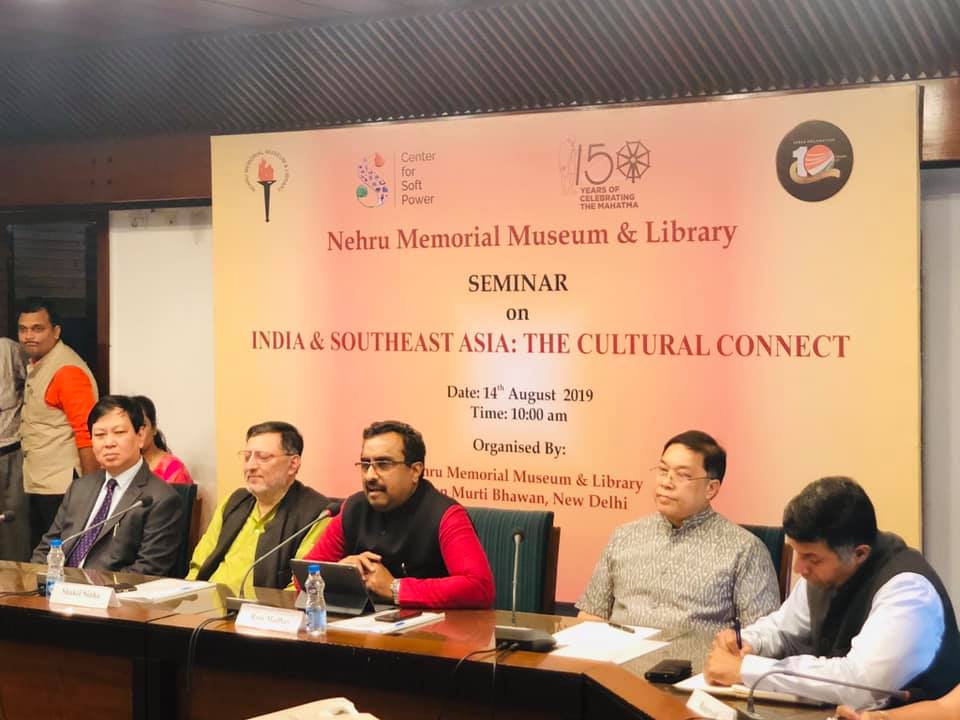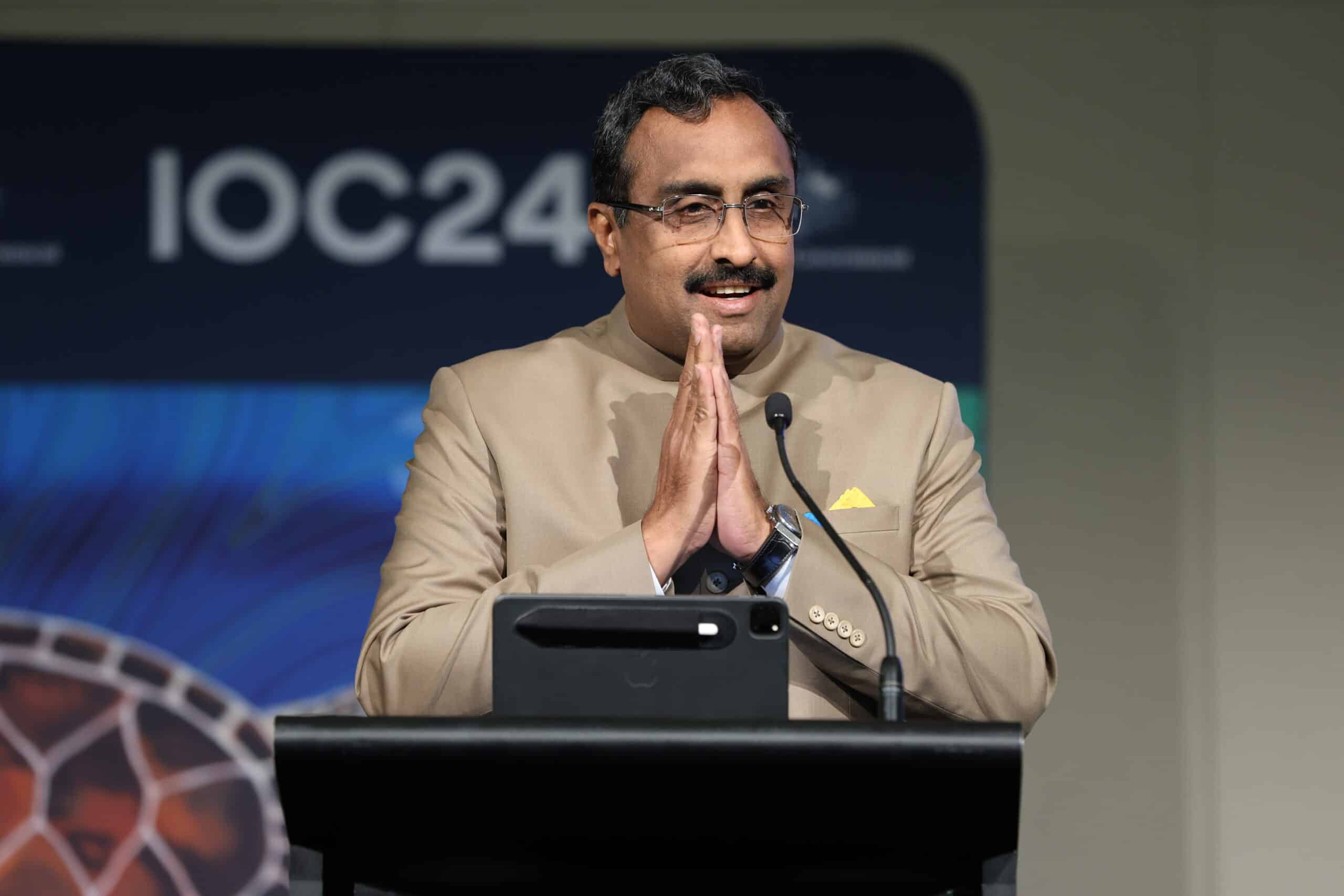
|
Getting your Trinity Audio player ready...
|
Text of Shri Ram Madhav’s Keynote Address at the Seminar on “India – South East Asia: A Cultural Connect”
Indians have largely forgotten that they had a vast area of influence over the territories of South East Asia in the first millennium of the current era until some European scholars, like French scholars George Coedes and Sylvain Levi started exploring and digging deep into the story in 19th and 20th centuries. Indian scholars like Neelakantha Sastry have picked up threads from there in the 20th century; yet the Indian scholarship in these areas is meagre.
The Indian foray into the lands to its east, in the vast oceans, had started in the 1st century CE itself and continued till the early centuries of the second millennium. The greater preoccupation of the Indian ruling elite with the aggressions from the West, which began towards the end of the first millennium and continued through endless battles in the entire second millennium, had resulted in a disconnect between the mainland and its cultural extensions.
The recorded history of the Indian influence in the first millennium extended from Mekong basin to Malay Peninsula. Archaeological remnants of this influence like the magnificent temple complex at Angkor in Cambodia still stand in many parts of the region, which was christened as ‘Farther India’ or ‘Greater India’ by the scholars. Not just archaeological sites; many countries in the region still carry the cultural and religious influence in their language, art, dance, drama, festivals and even family, society and statecraft. For example, the king in Thailand is called Rama even today and the present king is Rama X.
Although the European historians described the area that went under Indian influence as ‘Greater India’ or ‘Farther India’, this description may not be fully apt for the important reason that the Indian migrants – royals, sailors, traders, monks – didn’t encounter any uncivilised savages in the lands that they had visited. On the contrary, they were organised societies endowed with a value system that had many similarities with that of the visitors. Thus the so-called Indianisation of Farther India is an exaggeration because what actually happened was the communion of the Indian and native cultures.
Interplay of Cultures
Both India and South East Asia had been inhabited since prehistoric times by organised settlements that were not only foraging but also pastoral and agricultural. Historically people have migrated and merged, intermingled and exchanged. Neither culture has any pristine reality.
The interplay of cultures had begun in this region at the advent of the first millennium of the Common Era. Ptolemy was one of the first to record this engagement besides some Chinese scholars in 2nd and 3rd Century AD. First recorded engagement was at Funan, the lower Mekong delta encompassing southern Vietnam and Malay peninsula, in 1st Century AD itself. It was recorded that an Indian traveller by name Kaundinya had arrived in the kingdom of Funan, married the princess and established first ever Indian empire in the region. Excavations of the Pyu settlements in present day Myanmar show evidence of the earliest South East Asian contacts with India, and one of the sites is called Beikthano, distortion of ‘Vaikuntha’, the ‘City of Vishnu’.
Successive waves of migrations happened from kingdoms like Kalinga in Orissa to Cholas, Pallavas and Pandya in Tamil Nadu.
It was around this time that the Chinese too were venturing into the same geographical area. Parts of the region, like northern Vietnam had seen the influence of the Chinese much before the Indian influence travelled there. But there was a marked difference in the way the expansion happened. In the case of the Chinese, the soldiers had their boots first on the ground followed by the traders. Thus the Chinese influence was limited to the areas which came under the subjugation of the Chinese army which was followed by the Chinese traders.
Indian influence didn’t follow that trajectory. Hardly any military operation occurred from the Indian side in this region. It was always a benign influence through Hindu priests, Buddhist monks and other religious scholars followed by sailors and traders. In fact the major influence on these regions has been that of Hinduism and Buddhism, the markers of it are still present for everyone to see.
Sanskrit as a language too had a vast influence over the languages and literature of the region. Ramayana is the most popular story in many countries in the region even to this day. It is Ramakien in Thailand, which has a city called Ayutthaya named after Ayodhya. In Lao PDR, the popular version of the Ramayana is called Pha Lak Pha Lam, whilst in the Philippines, the folk narrative holds much resemblance to the Ramayana. An adaptation of the Ramayana called the Yama Zatddaw was popular in an oral tradition in Myanmar. In Indonesia, the Ramayana is called the Kakawin Ramayana. In the Malay peninsula it is called the Ramayana Hikayat Seri Rama.
The migrations had led to establishment of Chinese and Indian kingdoms in the South East Asian region, from Cambodia to Bali, the Indians, unlike the Chinese, were hardly seen as colonisers. While the Chinese became the rulers of the regions that came under their influence, the Indians were content with advising local chiefs who were converted to the religion that the migrants brought with them.
Eminent historian K A Nilakantha Sastry, in his address to the 9th session of the Indian History Congress in 1946, highlights that the Indian penetration or infiltration seems almost always to have been peaceful; nowhere was it accompanied by destruction.
Elaborating on this point, Coedes writes: “Far from being destroyed by the conquerors, the native peoples of Southeast Asia found in Indian society a framework within which their own society could be integrated and developed. The Indians nowhere engaged in military conquest and annexation in the name of a state or mother country. The countries conquered militarily by China had to adopt or copy her institutions, her customs, her religions, her language, and her writing. By contrast, those which India conquered peacefully preserved the essentials of their individual cultures and developed them, each according to its own genius. It is this that explains the differentiation, and in a certain measure the originality, of the Khmer, Cham and Javanese civilisations, in spite of their common Indian origin”.
After almost a millennium, the organised Indian re-engagement with this region began towards the end of the second millennium. It goes to the credit of Prime Minister P V Narasimha Rao for articulating the idea of Look East in early 90’s of the last century. Under Vajpayee, it has been upgraded to Act East Policy. The Government of India is today actively engaged in strengthening relations with the ASEAN countries, which primarily constitute the region of our cultural influence in the past. Efforts are underway to preserve, protect and restore many of the symbols and structures that represent the civilizational bonds between ASEAN and India.
One of the major linkages between the region and India was trade. Indians had always regarded this region as the ‘Land of Gold’ – ‘Suvarna Bhumi’. There was gold rush followed by trade in spices and precious metals. The Gupta dynasty in North India and the Chola dynasty in South had major trade going on between the region and India. Traders and sailors were our ambassadors.
We have a free trade agreement with ASEAN today and the bilateral trade has touched $ 90 billion.
Of equal importance had been the academic engagement. Universities like Nalanda and Sanchi, which were centres of higher learning in Hindu and Buddhist scholarship, used to be a major destination for students from many countries in the Farther India. Government of India has taken steps, in collaboration with countries in the region, to develop Nalanda University to its past glory.
Cultural and intellectual exchanges and people-to-people contacts should constitute an important pillar of our relations with the region. The Mekong Ganga Cooperation, a modern grouping aimed at reviving cooperation between the peoples of the Mekong and Ganga river basins in the fields of tourism, education, culture and people-to-people contacts is an important initiative in this direction.
India and South East Asia: Connectivity
Connectivity is key to facilitating socio-cultural exchanges and an important priority that we are working on. India shares both a land and maritime boundary with ASEAN. The linkages between ASEAN and India’s North Eastern states and communities are not just of close geographical proximity but of blood relations. The Tai race from Thailand has its descendants, the Ahoms, living in the north-eastern state of Assam.
The Khamtis who are descendants of the Tai from Thailand and Myanmar are also found in both Assam and Arunachal Pradesh. Meanwhile, the Khasis in Meghalaya are believed to have ancestral links to Thailand. However, we still need to do a lot of work in the connectivity area, both through land as well as the sea.
The immigrant Indian population that was sent to South East Asia in the 18th and 19th centuries as plantation and mining workers by the British rulers, is a major asset for us. Malaysia alone has nearly 2 million persons of Indian origin, constituting the second largest Indian diaspora abroad, after the United States. They play an important role in the social and public life of the country.
All this calls for a lot of research and study. Sadly, the Indian scholars have simply forgotten that they had vast regions in their extended neighbourhood that had a living civilisation and culture partially, if not fully, ingested from India. It was left to the French and other European academics in the last century to explore this dimension of India. It is time the scholars in the region take more interest in this subject.
Out of the goodwill that is generated by this cultural communion shall emerge a strong bonding between the regions of Ganga and Mekong – MA Ganga as some call it, for greater engagement and cooperation in the years to come.



